NCERT Solutions for Exercise 4.3 Class 9 Maths Chapter 4 - Linear Equations in Two Variables
NCERT Solutions for Class 9 Maths Chapter 4 Linear Equations In Two Variables: Exercise 4.3- Download Free PDF
NCERT Solutions for Class 9 Maths Exercise 4.3 introduces the notion of linear equations in two variables, as well as how to graphically solve linear equations. Linear equations in two variables are equations with a wholly unique solution, no solution, or infinitely many solutions of the form ax+by+c=0, in which a, b, and c are real numbers. To identify the set of solutions to the linear equations with two variables, we must first determine the value of the variables. The graphical representations of linear equations in two variables in graphs were the main topic of the NCERT book Class 9 Maths chapter 4 exercise 4.3. The basic strategy to display linear equations on the graph and discover the point of the equation on the graph is the graphical method of solution of linear equations in two variables. (x, y) is the form in which the solution to a system of linear equations is written.
NCERT solutions for Class 9 Maths chapter 4 exercise 4.3 include eight questions, four of which are Long Answer Questions, two of which are Short Answer Questions, one of which is a Multiple Choice Question, and the remaining one is the Main Question with five sub-questions. This Class 9 Maths chapter 4 exercise 4.3 thoroughly explains the fundamentals of linear equations in two variables. The following exercises are also included along with NCERT syllabus Class 9 Maths chapter 4 exercise 4.3.
NCERT Solutions for Class 9 Maths Chapter 4 – Linear Equations in Two Variables Exercise 4.3
Access Linear Equations In Two Variables Class 9 Maths Chapter 4 Exercise: 4.3
Q1 (i) Draw the graph of each of the following linear equations in two variables: $x + y = 4$
Answer:
Given : $x + y = 4$

Putting x=0,we have $y=4-0=4$
Putting x=1,we have $y=4-1=3$
Thus, (0,4) and (1,3) are solutions of given equation.
Q1 (ii) Draw the graph of each of the following linear equations in two variables: $x - y = 2$
Answer:
Given : $x - y = 2$

Putting x=0,we have $y=0-2=-2$
Putting x=1,we have $y=1-2=-1$
Thus, (0,-2) and (1,-1) are solutions of given equation.
Q1 (iii) Draw the graph of each of the following linear equations in two variables: $y = 3x$
Answer:
Given : $y = 3x$
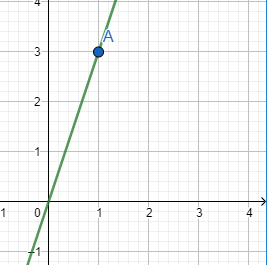
Putting x=0,we have $y=3(0)=0$
Putting x=1,we have $y=3(1)=3$
Thus, (0,0) and (1,3) are solutions of given equation.
Q1 (iv) Draw the graph of each of the following linear equations in two variables: $3 = 2x + y$
Answer:
Given : $3 = 2x + y$

Putting x=0,we have $y=3-2.(0)=3$
Putting x=1,we have $y=3-2.(1)=1$
Thus, (0,3) and (1,1) are solutions of given equation.
Answer:
The equations of two lines passing through (2, 14) are given by : $x+y=16\, \, and\, \, x-y=-12$
There are infinite lines passing through (2, 14) because infinite lines pass through a point.
Q3 If the point (3, 4) lies on the graph of the equation $3y = ax+ 7$ , find the value of a .
Answer:
Given : the point (3, 4) lies on the graph of the equation $3y = ax+ 7$
Put x=3 and y=4
$3y = ax+ 7$
$\Rightarrow 3(4) = a(3)+ 7$
$\Rightarrow 12 = 3a+ 7$
$\Rightarrow 12 -7 = 3a$
$\Rightarrow 5 = 3a$
$\Rightarrow a=\frac{5}{3}$
Answer:
Given: The distance covered as x km and total fare is Rs. y.
Total fare =the fare for first km + the fare of the remaining distance
$\therefore y=8+5\times (x-1)$
$\Rightarrow y=8+5x-5$
$\Rightarrow y=3+5x$
For graph,
Putting x=0, we have $y=3+5(0)=3$
Putting x=1, we have $y=3+5(1)=8$
Putting x=2, we have $y=3+5(2)=13$
Hence,(0,3),(1,8) and (2,13) are solutions of equation.
The graph is as shown :

Q5 (A) From the choices given below, choose the equation whose graph is given in Fig. 4.6.
(i) $y = x$
(ii) $x + y = 0$
(iii) $y = 2x$
(iv) $2 + 3 y = 7x$
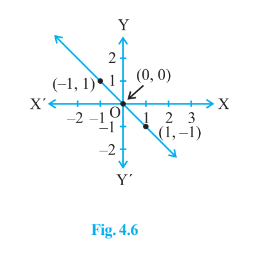
Answer:
For the given figure :
Points on line are (-1,1) , (0,0 ) and (1,-1)
$x + y = 0$ satisfies all the above points.
Thus, $x + y = 0$ is the correct equation of the line.
Q5 (B) From the choices given below, choose the equation whose graph is given in Fig. 4.7
(i) $y = x + 2$
(ii) $y = x - 2$
(iii) $y = -x + 2$
(iv) $x + 2y = 6$
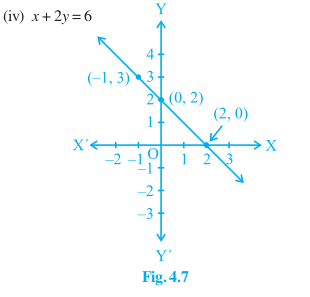
Answer:
For the given figure :
Points on line are (-1,3) , (0,2 ) and (2,0)
$y = -x + 2$ satisfies all the above points.
Thus, $y = -x + 2$ is the correct equation of the line.
Answer:
Let work done be y and distance be x.
Given : Constant force = 5 units
Work done by a body on the application of a constant force is directly proportional to the distance travelled by the body.
i.e. $y\, \, \alpha \, \, x$
$\Rightarrow y=kx$
k=Constant force = 5
Then,
$\Rightarrow y=5x$
For graph,
Put x=0,we have $y=5(0)=0$
Put x=1,we have $y=5(1)=5$
Put x=2,we have $y=5(2)=10$
Points are (0,0) , (0,5) and (2,10)
If the distance travelled is 2 units then the work done is 10 units.

Answer:
Let work done be y and distance be x.
Given : Constant force = 5 units
Work done by a body on the application of a constant force is directly proportional to the distance travelled by the body.
i.e. $y\, \, \alpha \, \, x$
$\Rightarrow y=kx$
k=Constant force = 5
Then, $\Rightarrow y=5x$
For graph,
Put x=0,we have $y=5(0)=0$
Put x=1,we have $y=5(1)=5$
Put x=2,we have $y=5(2)=10$
Points are (0,0) , (0,5) and (2,10)
If the distance travelled is 0 units then work done is 0 units.
Answer:
Let the contribution of Yamini be x.
contribution of Yamini be y.
According to question,
$x+y=100$
For x=0 , we have $y=100-0=100$
For x=10 , we have $y=100-10=90$
For x=20 , we have $y=100-20=80$
Hence, (0,100) , (10,90) and (20,80)
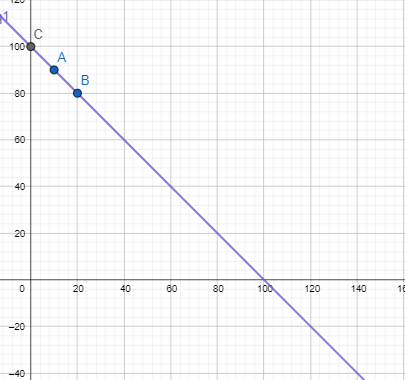
Draw the graph of the linear equation above using Celsius for x-axis and Fahrenheit for the y-axis.
Answer:
Let celsius be on x-axis and Fahrenheit be on y-axis.
$F = \left(\frac{9}{5} \right )C + 32$
For graph,
Putting x=0, we get $y= \left(\frac{9}{5} \right )(0)+ 32=32$
Putting x=5, we get $y= \left(\frac{9}{5} \right )(5)+ 32=41$
Putting x=10, we get $y= \left(\frac{9}{5} \right )(10)+ 32=50$
Hence, points are (0,32) , (5,41) and (10,50).
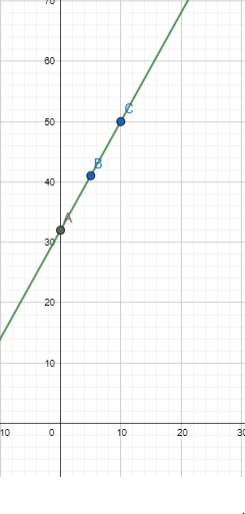
If the temperature is 30°C, what is the temperature in Fahrenheit?
Answer:
$F = \left(\frac{9}{5} \right )C + 32$
Put c=30,
$F = \left(\frac{9}{5} \right )30 + 32=54+32=86$
Thus, the temperature = 30°C, then the temperature is 86 in Fahrenheit.
If the temperature is 95°F, what is the temperature in Celsius?
Answer:
$F = \left(\frac{9}{5} \right )C + 32$
Put F=95,
$95 = \left(\frac{9}{5} \right )C + 32$
$\Rightarrow \left(\frac{9}{5} \right )C=95 -32$
$\Rightarrow \left(\frac{9}{5} \right )C=63$
$\Rightarrow C=35$
If the temperature is 95°F, then 35 is the temperature in Celsius.
If the temperature is 0°C, what is the temperature in Fahrenheit and if the temperature is 0°F, what is the temperature in Celsius?
Answer:
If the temperature is 0°C,
$F = \left(\frac{9}{5} \right )C + 32$
$F = \left(\frac{9}{5} \right )(0) + 32$
$\Rightarrow F = 32$
if the temperature is 0°F,
$F = \left(\frac{9}{5} \right )C + 32$
$0= \left(\frac{9}{5} \right )C + 32$
$\Rightarrow \left(\frac{9}{5} \right )C=- 32$
$\Rightarrow C=- 17.8$
Thus, if the temperature is 0°C , then the temperature in Fahrenheit is 32 and if the temperature is 0°F, then the temperature in celsius is -17.8.
(v) Is there a temperature which is numerically the same in both Fahrenheit and Celsius? If yes, find it.
Answer:
$F = \left(\frac{9}{5} \right )C + 32$
Let temperature be x in both Fahrenheit and celsius.
$x= \left(\frac{9}{5} \right )x + 32$
$\Rightarrow 5x= 9x + 160$
$\Rightarrow 5x-9x = 160$
$\Rightarrow -4x = 160$
$\Rightarrow x = -40 ^\circ$
Thus, 40 is the temperature which is numerically the same in both Fahrenheit and celsius.
More About NCERT Solutions for Class 9 Maths Exercise 4.3
A horizontal line and a vertical line divide a Cartesian plane into four areas, with the horizontal line known as the X-axis and the vertical line known as the Y-axis. The origin is also known as the point where both axes meet, and its value is (0, 0) . In Class 9 Maths chapter 4 exercise 4.3, to solve linear equations in two variables graphically, we must first build the graph of the equations by drawing a table for different values of x and y and then display the points on the graph for each equation using the values. Then we'll be able to connect all of the points. As a result, we have the graph. every point on the line satisfies the equation of the line in exercise 4.3 class 9 maths and every solution of the equation is a point on the line.
Benefits of NCERT Solutions for Class 9 Maths Exercise 4.3
• NCERT solutions for Class 9 Maths exercise 4.3 assists us in solving and revising all questions in these exercises, as well as gaining a better understanding of two-variable linear equations.
• If you go through the NCERT solution for Class 9 Maths chapter 4 exercise 4.3, we may gain practice from solving all the questions based on graphical representations of linear equations in two variables and get an overall idea about the topic.
• Exercise 4.3 Class 9 Maths, which is based on graphical representations of linear equations in two variables, will be useful in Class 10 Maths chapter 3 exercise 3.2 - pairs of linear equations with two variables.
Key Features of 9th Class Maths Exercise 4.3 Answers
Expertly Crafted Solutions: The solution for class 9 maths chapter 4 exercise 4.3 have been prepared by subject matter experts. They ensure accuracy and clarity in explanations.
Comprehensive Coverage: Exercise 4.3 class 9 maths covers various topics related to quadratic equations and their solutions. It includes problems involving quadratic equations in one variable.
Step-by-Step Format: Class 9 maths ex 4.3 Solutions are presented in a step-by-step format, making it easy for students to follow the solution process and understand the concepts.
Conceptual Clarity: The primary objective of ex 4.3 class 9 is to help students develop a clear understanding of quadratic equations and their solutions.
Variety of Problems: This Exercise 4.3 class 9 maths offers a range of problems with different levels of complexity, allowing students to practice and enhance their problem-solving skills.
PDF Availability: Solutions are often available in PDF format, allowing students to download and access them offline for convenient studying.
Free of Charge: These resources are typically provided free of charge, making them accessible to all students.
Also see-
NCERT Solutions of Class 10 Subject Wise
Subject Wise NCERT Exemplar Solutions
Frequently Asked Questions (FAQs)
X-coordinate is also called the abscissa
The y-coordinate is also known as ordinate.
The positive values of x and y are in quadrant I. Thus quadrant I is known as the positive quadrant.
Quadrant 4 is Both positive and negative. Reason: In quadrant 4, the x-coordinates are positive whereas the y-coordinates are negative.
Because the term xy is of degree 2, xy-2=7 is not a two-variable linear equation.
(-7, 8) corresponds to the II quadrants, according to NCERT solutions for Class 9 Maths chapter 4 exercise 4.3.
The graphical method of solution of the linear equations is the basic approach to represent the linear equations on the graph and find the point of the given equation.
Popular Questions
Courses After 12th
Applications for Admissions are open.
As per latest syllabus. Physics formulas, equations, & laws of class 11 & 12th chapters
JEE Main Important Chemistry formulas
Get nowAs per latest syllabus. Chemistry formulas, equations, & laws of class 11 & 12th chapters
JEE Main high scoring chapters and topics
Get nowAs per latest 2024 syllabus. Study 40% syllabus and score upto 100% marks in JEE
JEE Main Important Mathematics Formulas
Get nowAs per latest syllabus. Maths formulas, equations, & theorems of class 11 & 12th chapters
